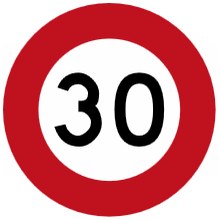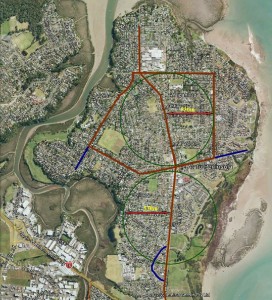 Guest post by Bryce Pearce, one of our people out west
Guest post by Bryce Pearce, one of our people out west
I cycle and love to see kids and adults cycling. You know, just getting around. What I hate to see is the line of parents in their cars dropping the children off to school in the morning and picking them up again in the afternoon. Why does this happen and what affect does it have on the ability of others to ride or walk to school?
We have one road to cross when I walk the little guy to school and unfortunately it also leads to a second school entrance so at the peak times it is a pain to cross. It does not help that it has the big wide corners associated with street design in New Zealand (you never know when that articulated truck will need to get around the corner at the same time as fire engine coming the other way. Better design it to cope, because you know…)
Now, I have seen the blogs, discussion, images and videos of the Netherlands and the fantastic infrastructure but the fact of the matter is that, we, in New Zealand are not ready to accept the fact that the costs involved are serious if one wants to be serious about it. I would vote for 10% of the transport budget to go to cycling tomorrow but I think I’m part of a small group.
Intermission: Mandatory Dutch example on how to do it right
So, what else can be done? Read on. There has been a lot of chatter on the Te Atatu Facebook page about the speed of traffic around the place and also a few close calls and actual accidents involving children, but also adults, and motor vehicles.
A Travelwise survey was also done by recently by Auckland Transport and Matipo Primary School (which I have used as it is the school my son goes to) and it shows (results link) that safety is a prime reason in the lack of pupils walking and cycling to school (convenience is the other but we cannot do much about that). Currently just 3% of pupils at Matipo cycle to and from school. Results from the survey indicate that 20% of the pupils would like to cycle to school – but I’m guessing concerns from the parents about safety overrule what the children think, so we end up with almost 9 our of 10 children who want to ride to school not doing so.
How do we change that perception of the lack of safety – real or otherwise? If we could get 20% cycling to school, would the peer group also take up that mode and drive the figures higher? I believe so. After some research about what the rest of the world is doing I have come up with a potential, relatively low cost solution.
Firstly there’s some reading on the effects of slower speeds on safety – note that 20 mp/h = 32 km/h, so one country’s 20 mp/h campaign is anothers 30 km/h campaign. And the benefits are nothing short of a magic bullet (read the short abstract at the top if the long version is too, well, long) – on average, road casualties dropped by over 40% once such slow-speed zones were introduced, with even more marked reductions in the injury and death rates of young children.
Now, the transport budget in NZ and Auckland is heavily swayed toward roading (at this time) with cycling and walking getting slightly less than 1% of the annual transport budget from Auckland Council along with the occasional directly-funded project from NZTA (also using less than 1% of their transport budgets for it), which leaves us well short of the funding required to create a Dutch style cycle network. This is where speed reductions come in.
 Te Atatu Peninsula is only 3.5km long and 2.4km across so cycling around should be easy – however, it’s not, mostly due to unfriendly road design, a lack of suitable crossings and high vehicle speeds. So, 30 km/h zones then. I have drawn a map of how this could work on ‘the Peninsula’.
Te Atatu Peninsula is only 3.5km long and 2.4km across so cycling around should be easy – however, it’s not, mostly due to unfriendly road design, a lack of suitable crossings and high vehicle speeds. So, 30 km/h zones then. I have drawn a map of how this could work on ‘the Peninsula’.
The roads that have no lines drawn on them are part of the 30 km/h zone. The lines in blue are where I was undecided or where, in the case of Old Te Atatu Road, it is still currently part of the bus network so it should stay as a 50 km/h road. Red would stay at 50 km/h.
A 30 km/h street is suitable for children to cycle on as the speed of motor vehicles is such that there is ample time to stop a vehicle if a child crosses a road without looking or swerves on a bike. In the Netherlands, a 30 km/h street is a shared street (not to be confused with a very low speed ‘shared space’) where cyclists and pedestrians have equal rights as motor vehicles and if someone is crossing a road it is expected that a car driver will slow and let them cross.
Could this work? Do you think the safety benefits can be duplicated in New Zealand? Surely we have to give it a try given how easy and cost effective it appears to be?



